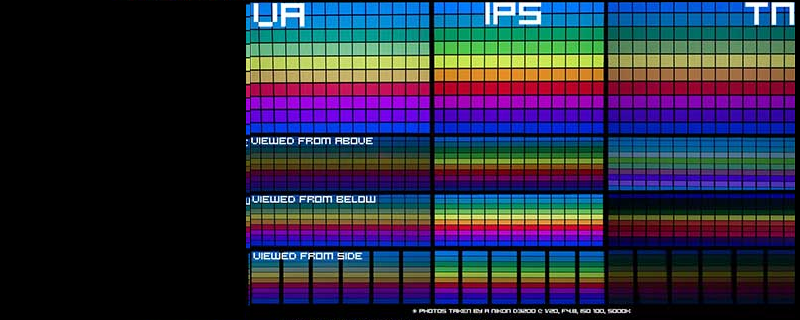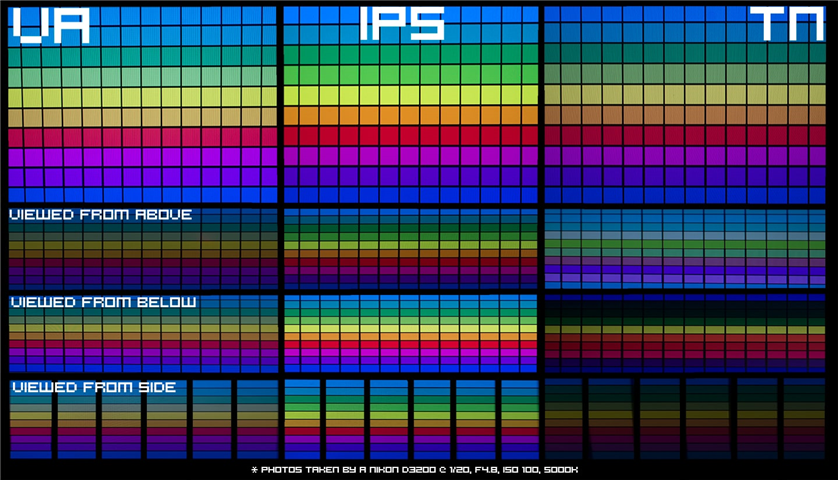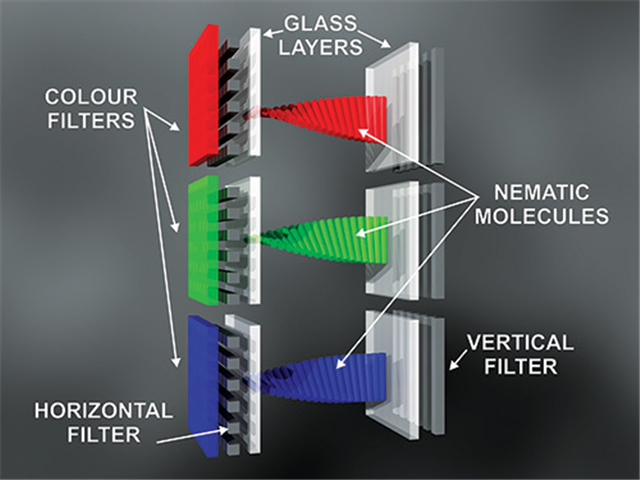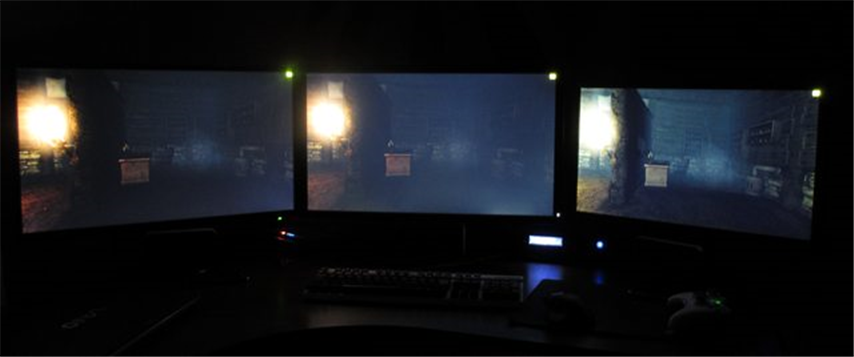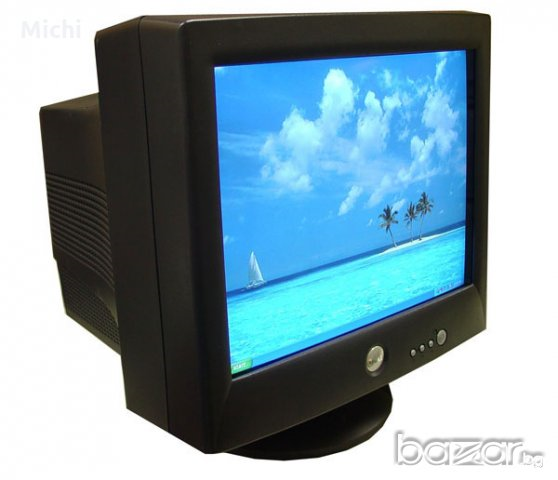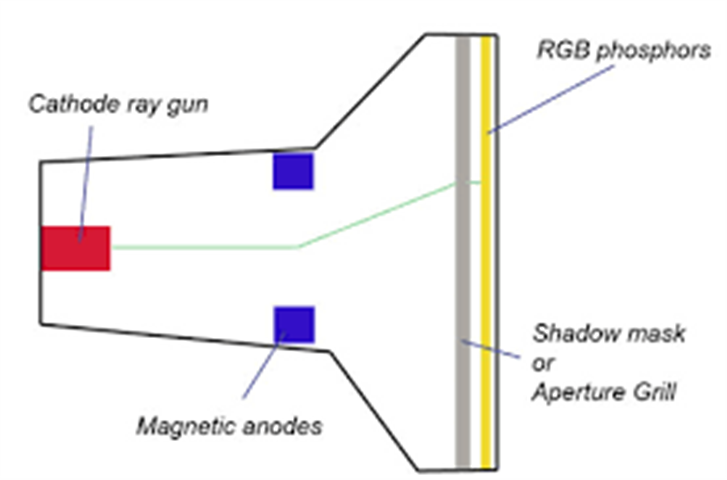
In this article we will explore the different types of display panel types available on the market. We will cover the most popular and some very niche or near obsolete options to give our fans a good overview.
LCD (Liquid-crystal display)
Let us begin with the most popular type of display panel Liquid-crystal displays or LCDs. Here we have three main types of LCD technology:
TN or Twisted Nematic, In-Plane Switching or IPS, and Vertical Alignment or VA. TN is most common on computer monitors although IPS is also very common, while VA is most common on low-end TVs, but is slowly gaining ground in PC monitor spaces.
LCD technology has some real and inherent disadvantages when compared to CRT, Plasma, and OLED, mostly because of the fact that LCDs rely on backlighting (either edge-lit like all computer monitors, or literally backlit on higher end TVs) while CRT, Plasma, OLED produce light on the surface for each and every pixel. This means that those other display types have superior contrast ratios, deeper blacks, more pure whites, far richer and fuller colors. For example, blacks are only true blacks on CRT/Plasma/OLED, not LCD, since the pixel actually has no light on these unlike LCD. LCDs also use sample and hold which leads to a lot more motion blur especially compared to CRT and SED/FED.
Still, LCDs are not without merit and price is a very important feature. Let us go over the different types of LCD now.
TN (Twisted Nematic) – LCD
This is actually the cheapest (on average) and most common computer monitor type. It does have some really nice advantages though.
Pros:
- TNs are generally cheap to make. This also usually means a lower cost for the consumer!
- Very good response times. Some of the best being under 3 ms!
- Many possible configurations in both size, resolution, and refresh rate.
- Higher peak brightness than Plasma and OLED, especially for LED backlit models which is basically most modern LCDs.
Cons:
- Poorer colour accuracy.
- Poor contrast ratio. Good models can do 950:1.
- Lackluster black levels.
- Many use thick grainy TN film screen coating that damages image quality even more.
- Very bad viewing angles. Gamma shift can be encountered from even slight movements.
- Backlight bleeding is quite probable.
TN panels have two large advantages over other types. Cost and response time. It should be noted that even though inferior to IPS and VA for colour critical work, a good, high-end TN monitor with good calibration can still look quite decent for most use cases. It won’t beat decent VA or IPS, but it can still offer a nice visual experience. Good response times and low motion blur can make a TN look great in action.
VA (Vertical Alignment) – LCD
This is the panel type used in many slightly older HDTVs. Overall it is a very nice and increasingly popular LCD panel type although the potential has yet to be fully realized in computer monitors.
Pros:
- Great contrast ratios, the best of all LCD panel types. Average is 2500:1 or 3000:1. Some TVs do 4000:1 and a few even achieve 7000:1.
- The best black levels of all LCD panel types. It is nowhere near some other technologies, but it is superior to LCD and TN.
- Decent colour accuracy out of the box on most models. Please do note, this depends on the monitor, but we have noticed reasonable calibration
out of the gate on most VAs.
- High refresh rate models are now readily available.
- Better viewing angles than TN, much better even! Still not as good as IPS though, let alone OLED or CRT.
- Decent average response times, especially on very good models.
- Less blacklight bleed than other LCDs, full array LED VA TVs have none at all even.
- Higher peak brightness than Plasma and OLED.
- Quantum dot technology improves colour space and accuracy, as well as brightness and performance in bright rooms.
Cons
- Inconsistent response times. Most VA displays have at least a few very slow transitions. Black to dark grey or just black to grey are the most common culprits, even if other transitions are good or even fast. As a result, VAs offer better minimum response times than IPS, but worse average and maximum response times than IPS. It should be noted that some higher end panels seem to have this issue mostly figured out though.
- “Black crush” which causes a loss in black detail (e.g., grey detail lost in black content). Compared to TN’s dark grey blacks and IPS’s white blacks, this isn’t a cause for concern save for color critical work, but it is a real con.
- Usually more expensive than TN, especially when matching features.
- Viewing angles are still lacking. Better than TN but not like IPS.
These monitors are seeing a slow rise in popularity these days and we really like that. Read reviews carefully of course, but VAs can offer excellence in immersive games and do a great job even in competitive titles. If they are good that is.
IPS (In-Plane Switching) – LCD
IPS is the most used panel type for photo editing, because of all LCD panels it has the best color accuracy. It is becoming more and more common and may eventually overtake TN panels.
Pros:
- The best potential color accuracy of all LCD panels. Especially for professional panels, but even normal IPS monitors still have far better color accuracy than typical TN monitors though.
- Response times can be very good on state-of-the-art gaming IPS monitors.
- The widest viewing angles of all LCD panel types.
- Available with high refresh rates, up to 240 Hz on the Acer although their response time isn’t quite quick enough for 240 Hz.
- Higher peak brightness than Plasma and OLED.
Cons:
- Poor contrast ratio. The most once can find is around 1000:1 on computer monitors, maybe more on some rare IPS TVs.
- Mediocre black levels, the same as TN but made even worse by IPS glow. Which brings us to…
- IPS glow, which causes dark screens to appear white(ish) when viewed at angles. So IPS viewing angles aren’t perfect. IPS glow is very problematic on especially large monitors.
- High probability of backlight bleed.
IPS is a very good LCD panel type and it has many advantages, but it is not the end all be all of monitors. Still, we believe that it and VA are overall tied in their pros and cons. But remember, the specific panel and product (and price!) always matter more than the technology it is based off!
The image above is based on slightly older monitors, but it shows the difference in blacks in a similar scene. IPS (far left), TN (middle), and VA (right).
CRT (Cathode Ray Tube)
CRT monitors have gone out of fashion and very few are still in any sort of production. Any CRT monitors one finds are likely to be used or old stock. We mostly expect only really hardcore competitive gamers to use such monitors thanks to their response time advantage, but the truth is that modern ultra-high end LCDs with blur reduction can offer a good alternative here.
Some people still love them for that old, retro feel and look. CRT displays are powered by an electron gun, and they draw lines directly on the screen making it a self-emissive display. Thankfully, these lines are less sharp than today’s pixels seen on other display types.
Pros:
- High contrast ratio, even mediocre ones often do 15000:1.
- Near-perfect black depth due to being self-emissive.
- Excellent colour accuracy, especially if calibrated.
- Response time is under 1 ms. These things are almost instant. There is no perceivable motion blur from such monitors.
- Very wide viewing angles.
- Works well with high refresh rates.
- No backlight bleeding since there is no backlight.
- Lossless aspect ratio scaling and resolution scaling.
Cons
- CRTs are not in active production.
- Magnetic interference, which would be a deal breaker for a lot of people. Many modern audio components aren’t shielded and would suffer, for example.
- Poor ANSI contrast ratio, which sort of negates the general contrast spec.
- Bulky and heavy. Really good ones can weigh 40+ kilograms!
- As the monitor ages, the image may blur over time. However, CRTs can be refocused, some easier than others, so this shouldn’t be a permanent issue.
- Proper calibration can take hours and is tedious.
- Less maximum brightness than LCD, especially LED backlit LCD.
- Slightly less sharp image than LCD, OLED, Plasma.
Plasma
This tech was prominent in HDTVs for a while, before LCD became the big thing. We are covering it in case you find an old plasma TV and are wondering if it would be a good fit. It has excellent contrast ration, good blacks and no backlight. Viewing angles are also very good and there is almost no motion blur.
Plasma is generally excellent for watching movies and videos, but we do not recommend it for gaming due to its high lag.
OLED (Organic Light-Emitting Diode)
Like CRT and plasma, the light source is on the screen surface itself, hence the much better image. An OLED powers each and every subpixel. OLED may have the potential to be the best panel type for everything, but there are still some longevity concerns on many models and its higher cost is still an issue.
Pros:
- The best contrast ratio. De facto infinite for 99.99% of people.
- Perfect black levels since pixel light can be turned off completely.
- Extremely high refresh rates are not a problem.
- Can be made paper thin, curvy, in all sorts of shapes and sizes. The most flexible panel type, if there is engineering will and vision.
- Essentially instantaneous response time like CRT.
- Amazing viewing angles.
Cons:
- Longevity issues are almost solved, but not quite.
- They use sample and hold just like LCD technology, so motion blur still exists. However, there is already a blur reduction technique for it, used by Oculus Rift (black frame insertion).
- Image retention issues (mostly temporary).
- While colour accuracy is good, it is hard to make it excellent. Lots of calibration is needed on the manufacturer’s side and probably on the user’s side too. It will easily surpass all other panels, except a perfectly calibrated CRT.
- Less maximum brightness than LCD, especially LED backlit LCD.
- Still very rare and expensive on PC monitors. It is slowly but surely becoming cheaper though, and one day it may be dirt cheap.
OLED and its derivative technologies are extremely promising. The true testament to how this piece of technology has taken the TV world by storm. We hope that it continues to advance and becomes cheaper so that every gamer, no matter their style of play can enjoy it!
The articles content, opinions, beliefs and viewpoints expressed in SAPPHIRE NATION are the authors’ own and do not necessarily represent official policy or position of SAPPHIRE Technology.





